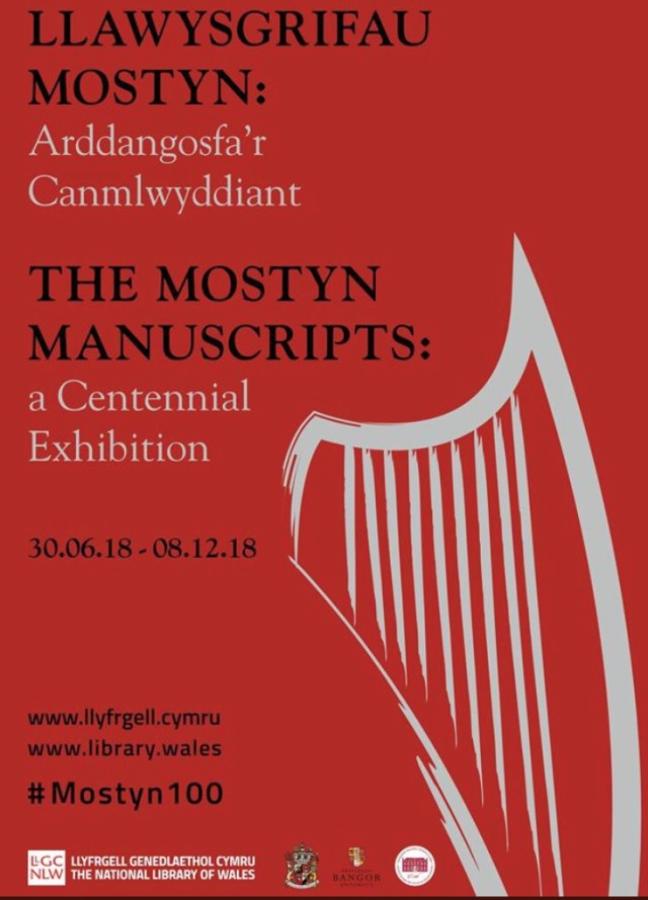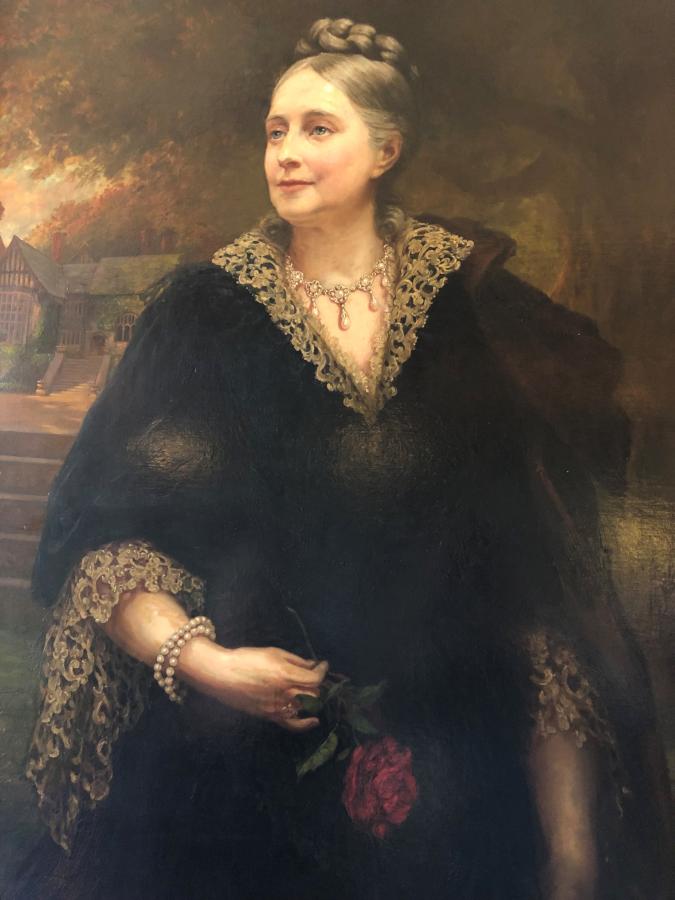Mostyn in Welsh History
The Mostyn family is one of the oldest landholding institutions in north Wales. Most famous for their role in the two seminal Caerwys eisteddfodau in 1523 and 1567, and their contribution towards the nineteenth-century development of the seaside resort of Llandudno, the family has exerted a significant influence on the histories, cultures and landscapes of the region since the medieval period.
As demonstrated by the research of the late Prof A. D. Carr, the Mostyn estate papers provide one of the best sources of evidence for tracing the development of landed estates in medieval Wales. Through a marriage, purchase and inheritance, by the sixteenth century the Mostyns had acquired a substantial landed interest right across north Wales: in Mostyn in Flintshire, Gloddaith in Caernarfonshire, Pengwern in Denbighshire and Trecastell and Tregarnedd in Anglesey. This landed power was linked to an outstanding Welsh ancestral heritage and provided the platform for the Mostyns to emerge as one of the leading gentry families in Wales.
The records and collections they accumulated provide entry points for analysing so many themes and issues, from bardic patronage, Welsh manuscripts and country house libraries, to coal mining, agriculture and urban development. The survival of the family’s two primary residences and estates at Mostyn and Gloddaith also provides significant inspiration for studies of visual and material culture.
You can find out more about aspects of the family’s history by exploring this timeline on the Mostyn Estates website.
The Mostyn Project
The Mostyn Project was launched in 2009 as an initiative of the Institute for Medieval and Early Modern Studies (IMEMS) with the aim of enhancing both academic and public awareness of, and engagement with, the rich bodies of historical evidence produced by or related to the Mostyn family and estate.
Early work on the project included three funded PhD projects, including that of our Director, a range of public and community engagement initiatives and an AHRC Cultural Engagement Grant focusing on the heritage of Llandudno.
Since 2015 ISWE has taken responsibility for the development of the project, maintaining the strong collaborative relationships with the National Library of Wales, Bangor University Archives and Special Collections and North East Wales Archives. Mostyn Estates and the Mostyn family continue to be important supporters of our research programme.
The Project now incorporates a spectrum of research and heritage initiatives based on the extraordinary Mostyn collections.

#Mostyn100 – The Mostyn Manuscripts

In 2018 we partnered with the National Library of Wales and Mostyn Estates to curate an exhibition programme focused on the important collection of Mostyn Manuscripts which were acquired by the National Library of Wales in 1918.
This exhibition and the lively programme of associated public events and activities provided an opportunity to showcase the richness of the Mostyn material, highlight the research which has already been undertaken and provide impetus for further scholarship.
The exhibition featured some of the most important manuscripts in the collection, alongside a selection of items from Mostyn Hall – including the famous ariandlws: the silver harp associated with the Caerwys eisteddfodau.
The programme culminated with a special symposium at the National Library of Wales in November 2018.
Mostyn Newsletters:
Networks of News: Reanimating the Mostyn Manuscript Newsletters and Correspondence (c.1672–1740)
Thanks to the grant made available by the Marc Fitch Fund in 2018 we have been able to digitise, research and make available an exceptional collection of three thousand letters from the 17th and 18th centuries kept in the library at Mostyn Hall in Flintshire.
The handwritten letters were received by Sir Thomas Mostyn (1651–92) and Sir Roger Mostyn (1673–1739) from a vast network of contacts and correspondents during the periods c.1672–92 and c.1721–40. It is one of the most comprehensive collections of letters surviving from 17th and 18th century Wales. During this period the Mostyns of Mostyn and Gloddaith were one of the most prominent gentry families in Wales. The letters relate to all aspects of their interests and activities, ranging from parliamentary affairs, religious debates and office-holding, through to book collecting, marriage strategies, education, antiquities and local gossip. They also include an unparalleled collection of personalised manuscript newsletters, sent from London to Gloddaith Hall, which provide detailed coverage on all aspects of national and international news.
The letters are bound into volumes which form part of the famous library at Mostyn. Thanks to the cooperation of Lord Mostyn, all of the letters have now been fully digitised offsite by Genus and the files are now with the University of Oxford waiting to be uploaded to the Early Modern Letters Online (EMLO) website.
The grant enabled Dr Mary Chadwick (now University of Huddersfield) and Dr Sarah Ward Clavier (UWE Bristol) to research and part transcribe the letters. This task also, importantly, included the extraction and preparation of a mass of metadata which will enable each letter to be fully searched, analysed and interrogated by the international scholarly community. There are significant research opportunities emanating from the digitisation of the letters which are being pursued by the project team.
We were also able to showcase the project at an important conference we organised at Brecon Cathedral in April 2019 on the subject of ‘Reading, Writing, and Collecting: Books and Manuscripts in Wales, 1450–1850’.
The life and influence of Lady Augusta Mostyn (1830–1912)

In 2019 were delighted to start a new research and cataloguing project, in partnership with Mostyn Estates and Bangor University Archives and Special Collections. This will see the papers of Augusta Mostyn catalogued and researched for the first time.
In 1855 Henrietta Augusta Nevill married Thomas Edward Mostyn Lloyd-Mostyn (1830–1851), the son and heir apparent of the 2nd Baron Mostyn. In May 1861 she was widowed following the death of her husband from consumption, being left to bring up her two young sons and dedicating her life to preserve the rightful inheritance of her eldest, Llewellyn Nevill Vaughan Lloyd-Mostyn (1856–1929), who would eventually succeed as 3rd Baron Mostyn on the death of his grandfather in 1884. His successful inheritance depended on finding a solution to the severe indebtedness of the family. Despite the continuing development of Llandudno, the scale and complexity of the family’s debts was becoming a serious problem. Lands needed to be sold in order to reduce the deficit but Lady Augusta argued forcefully that the sale of Llandudno would be detrimental to the interests of her son, considering it to be ‘the mainstay of the family’. She played a pivotal role in returning the family to a state of financial stability.
In 1879 she returned to live at the newly refurbished Gloddaith Hall, remaining there until her death in 1912. During her lifetime her contribution to the development of Llandudno and district was immense. She funded the building of Ysgol Bodafon in 1872, financed the construction of Marine Drive in 1877 and in 1898 she built All Saints Church (Deganwy) in honour of her parents, also contributing towards the building of St. Paul’s Church (Craig-y-Don). She oversaw the foundation of the Oriel Mostyn Art Gallery (opened 1902), stipulating that it should prominently display the works of female artists.
Over the next three years Dr Dinah Evans will be researching two chests of correspondence, accounts, diaries, receipts and legal papers which have just been deposited at Bangor Archives from Mostyn Hall. As part of the project the papers will be arranged and catalogued for the first time under the supervision of Elen Wyn Simpson, University Archivist.
The project builds on two strands of ISWE’s work; firstly the Mostyn Manuscripts exhibition held in collaboration with the National Library of Wales in 2018; and the conference held at the National Botanic Gardens of Wales in collaboration with Women’s Archive Wales in the same year, on the subject of the lives and experiences of women on estates in Wales.
It is anticipated that the research and catalogue will open up a raft of new insights into the life and influence of one of the most extraordinary women in the history of north Wales.
Sincere thanks to Lord Mostyn for his continued support. We wish Dinah every good wish with this important project.
Maes Mynan: Llys, Country House and Estate
Maes Mynan, located on the Denbighshire-Flintshire border near the town of Caerwys, is one of the great unknowns of Welsh history. Since the summer of 2019 we have been working with Flintshire County Council and Acorn Leisure to research the history of the site. Part of the old estate, with spectacular views of Moel y Parc, has recently been purchased and is being converted to a holiday park. The owners of the site want to ensure that the history and culture of Maes Mynan acts as a guide for how the park is developed and promoted, with a view to creating a distinctive, authentic and enjoyable visitor experience of this part of Wales. The park was formally opened by Lord Dafydd Elis-Thomas in September 2019, where he was presented with a copy of Dr Shaun Evans’ report on the history of the site. Maes Mynan was almost certainly a llys of the princes of Gwynedd and this designation, together with other aspects of its rich heritage, were discussed during the launch.
ISWE will continue to work with Flintshire County Council, Acorn Leisure and other partners to explore opportunities at the intersection of history, heritage, tourism and rural economic development.
